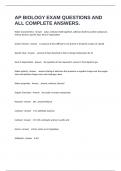AP BIOLOGY EXAM QUESTIONS AND
ALL COMPLETE ANSWERS.
Water characteristics - Answer polar, cohesion (hold together), adhesion (hold to another substance),
surface tension, specific heat, heat of vaporization
Surface Tension - Answer A measure of how difficult it is to stretch or break the surface of a liquid
Specific Heat - Answer amount of heat absorbed or lost to change temperature by 1C
Heat of Vaporization - Answer the quantity of heat required to convert 1 from liquid to gas
Water polarity - Answer uneven sharing of electrons that produces a negative charge near the oxygen
atom and positive charges near each hydrogen atom
Water properties - Answer solvent, cohesive, thermal
Organic Chemistry - Answer the study of carbon compounds
Hydroxyl - Answer OH-, alcohol/ethanol
Carbonyl - Answer C=O, aldehyde, keytone
Carboxyl - Answer O=C-OH, carboxylic acid as in acetic acid
Amino - Answer H-N-H, amine as in tryptophan
Sulfhydryl - Answer R-SH
,four organic compounds - Answer carbohydrates, lipids, proteins, nucleic acids
Monosaccharides - Answer glucose, fructose, galactose
Disaccharides - Answer sucrose, lactose, maltose
Polysaccharides - Answer glycogen, starch, cellulose
Glycogen - Answer storage polysaccharide form of glucose in animals
Starch - Answer storage polysaccharide form of glucose in plants
Cellulose - Answer Carbohydrate component of plant cell walls.
Condensation v. Hydrolysis - Answer Condensation: anabolic, water out
Hydrolysis: catabolic, water in
Protein (condensation/hydrolysis) - Answer Amino acid ---> dipeptide ---> polypeptide
Carbohydrates (condensation/hydrolysis) - Answer Monosaccharide ---> Disaccharide --->
Polysaccharide
Glycosidic bond - Answer bond formed by a dehydration reaction between two monosaccharides (+
water in product)
2 families of nitrogenous bases - Answer pyrimidines and purines
Complementary base pairing - Answer A & T = 2 hydrogen bonds
C & G = 3 hydrogen bonds
, DNA Structure - Answer Phosphodiester: between phosphates & sugars
Covalent: between sugar & base pair
Hydrogen: between base pairs
Protein Structure - Answer amino group-r side chain-carboxyl group
Primary - Answer amino acid sequence, peptide bonds
Secondary - Answer representing local structure, held by H+ bonds
Tertiary - Answer folding of a single protein
Quaternary - Answer protein complex
Two forms of proteins - Answer globular (insoluble, structural) and fibrous (soluble, functional)
Fibrous proteins - Answer long, insoluble, structural proteins (keratin, elastin)
Globular proteins - Answer chunk, soluble (amylase, insulin, hemoglobin, immunoglobin, transport
pumps)
Anabolic reactions - Answer build complex molecules from simpler ones, endergonic, biosynthetic
(example: photosynthesis)
Catabolic reactions - Answer breakdown of molecules, exergonic, degradative (example: cellular
respiration)
First Law of Thermodynamics - Answer Energy can be transferred and transformed, but it cannot be
created or destroyed.




